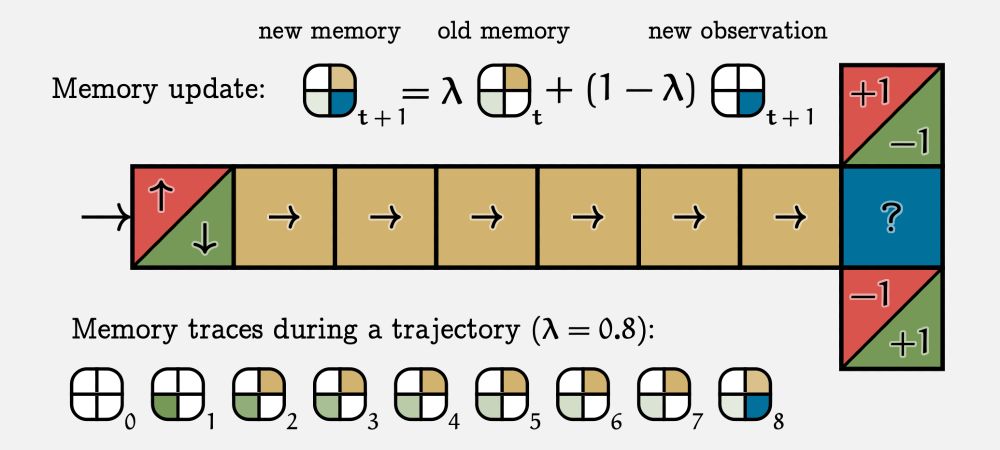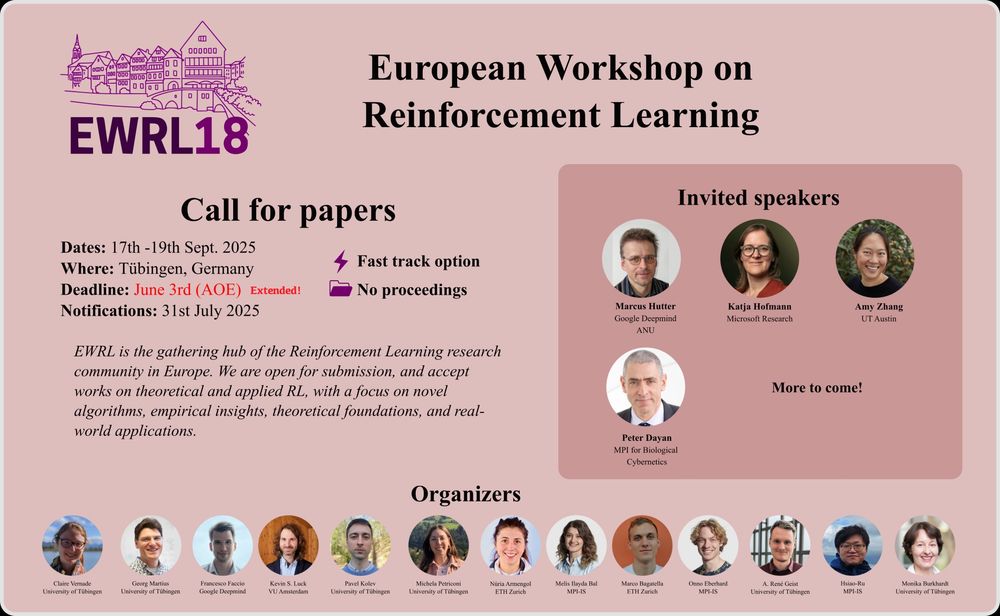Workshop on Reinforcement Learning 2026, taking place on 𝐅𝐞𝐛𝐫𝐮𝐚𝐫𝐲 𝟔, 𝟐𝟎𝟐𝟔, at the 𝐔𝐧𝐢𝐯𝐞𝐫𝐬𝐢𝐭𝐲 𝐨𝐟 𝐌𝐚𝐧𝐧𝐡𝐞𝐢𝐦, Germany.
Participation in the workshop is 𝐟𝐫𝐞𝐞 𝐨𝐟 𝐜𝐡𝐚𝐫𝐠𝐞!
Check the program and register: www.wim.uni-mannheim.de/doering/conf...

Workshop on Reinforcement Learning 2026, taking place on 𝐅𝐞𝐛𝐫𝐮𝐚𝐫𝐲 𝟔, 𝟐𝟎𝟐𝟔, at the 𝐔𝐧𝐢𝐯𝐞𝐫𝐬𝐢𝐭𝐲 𝐨𝐟 𝐌𝐚𝐧𝐧𝐡𝐞𝐢𝐦, Germany.
Participation in the workshop is 𝐟𝐫𝐞𝐞 𝐨𝐟 𝐜𝐡𝐚𝐫𝐠𝐞!
Check the program and register: www.wim.uni-mannheim.de/doering/conf...
If you want to talk about RL, causality, bandits, online learning, join us there on December 2nd
sites.google.com/view/ilir-wo...

If you want to talk about RL, causality, bandits, online learning, join us there on December 2nd
sites.google.com/view/ilir-wo...
Loved being part of it and meeting so many passionate reinforcement learning enthusiasts!
@ewrl18.bsky.social

Loved being part of it and meeting so many passionate reinforcement learning enthusiasts!
@ewrl18.bsky.social

aihub.org/2025/09/12/m...

Register now 👇 and join us in Tübingen for 3 days (17th-19th September) full of inspiring talks, posters and many social activities to push the boundaries of the RL community!
Register now 👇 and join us in Tübingen for 3 days (17th-19th September) full of inspiring talks, posters and many social activities to push the boundaries of the RL community!
Poster W #707
With intrinsic rewards for novel yet useful behaviors, SENSEI showcases strong exploration in MiniHack, Pokémon Red & Robodesk.
Accepted at ICML 2025🎉
Joint work with @cgumbsch.bsky.social
🧵
Poster W #707

He made a great thread about it, come chat with us about POMDP theory :)

He made a great thread about it, come chat with us about POMDP theory :)


arxiv.org/abs/2503.15200

arxiv.org/abs/2503.15200



Marcus Hutter (www.hutter1.net) is a Senior Researcher at DeepMind and Honorary Professor at ANU. His research focuses on the information-theoretic foundations of inductive reasoning and reinforcement learning.
⌛Still time to submit your paper or contributed talk proposal!

Marcus Hutter (www.hutter1.net) is a Senior Researcher at DeepMind and Honorary Professor at ANU. His research focuses on the information-theoretic foundations of inductive reasoning and reinforcement learning.
⌛Still time to submit your paper or contributed talk proposal!
Peter Dayan (www.mpg.de/12309370/bio...) is Director of the MPI for Biological Cybernetics and a pioneer in neuroscience and AI.
His work focuses on brain decision-making, the role of neuromodulators and neuronal malfunctions in psychiatric diseases .
🕙 Still time to submit!

Peter Dayan (www.mpg.de/12309370/bio...) is Director of the MPI for Biological Cybernetics and a pioneer in neuroscience and AI.
His work focuses on brain decision-making, the role of neuromodulators and neuronal malfunctions in psychiatric diseases .
🕙 Still time to submit!
Submit your work to EWRL — now accepting papers until June 3rd AoE.
This year, we're also offering a fast track for papers accepted at other conferences ⚡
Check the website for all the details: euro-workshop-on-reinforcement-learning.github.io/ewrl18/

Submit your work to EWRL — now accepting papers until June 3rd AoE.
This year, we're also offering a fast track for papers accepted at other conferences ⚡
Check the website for all the details: euro-workshop-on-reinforcement-learning.github.io/ewrl18/
We’re pleased to announce a new Call for Contributed Talks to bring novel and diverse viewpoints to EWRL2025.
Early-career researchers are especially encouraged to submit proposals and share their work with the community.
Full details: euro-workshop-on-reinforcement-learning.github.io/ewrl18/

We’re pleased to announce a new Call for Contributed Talks to bring novel and diverse viewpoints to EWRL2025.
Early-career researchers are especially encouraged to submit proposals and share their work with the community.
Full details: euro-workshop-on-reinforcement-learning.github.io/ewrl18/
Check the website for all the details: euro-workshop-on-reinforcement-learning.github.io/ewrl18/

Check the website for all the details: euro-workshop-on-reinforcement-learning.github.io/ewrl18/
When? September 17-19, 2025.
More news to come soon, stay tuned!

When? September 17-19, 2025.
More news to come soon, stay tuned!

When? September 17-19, 2025.
More news to come soon, stay tuned!
Well, I’ve got the fix for you, Neuralatex! An ML library written in pure Latex!
neuralatex.com
To appear in Sigbovik (subject to rigorous review process)

